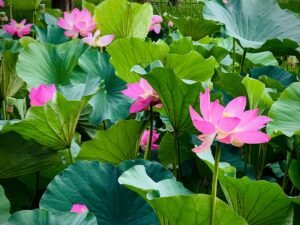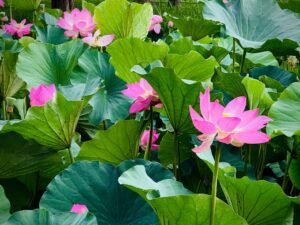

How to Form Simple Yes/No Questions in Chinese with “吗 (ma)”
The ability to form questions is a fundamental aspect of any language, and in Chinese, this is particularly interesting due to its unique structure and syntax. Unlike many Western languages that rely heavily on intonation or auxiliary verbs to indicate a question, Mandarin Chinese employs a more straightforward approach. One of the most common methods for forming yes/no questions in Chinese involves the use of the particle “吗 (ma).” This simple yet effective tool allows speakers to transform statements into questions with ease, making it an essential component of conversational Mandarin.
Understanding how to form yes/no questions is crucial for anyone looking to engage in meaningful dialogue in Chinese. It not only enhances communication but also provides insight into the language’s grammatical structure. As learners delve into the intricacies of Mandarin, mastering the use of “吗 (ma)” will significantly boost their confidence and fluency.
This article will explore the various aspects of forming yes/no questions in Chinese, focusing on the pivotal role of “吗 (ma)” and offering practical tips for effective communication. Start learning Chinese at the NLS Norwegian Language School in Oslo now!
Table of Contents
ToggleSummary
- Forming yes/no questions in Chinese involves using the particle “吗 (ma)” at the end of a statement.
- “吗 (ma)” is used to indicate that a sentence is a yes/no question in Chinese.
- The basic structure of yes/no questions in Chinese is similar to that of statements, with the addition of “吗 (ma)” at the end.
- “吗 (ma)” can be used with different verb tenses to form yes/no questions in Chinese.
- Adjectives and adverbs can also be used in yes/no questions in Chinese, with “吗 (ma)” placed at the end of the sentence.
Understanding the Role of “吗 (ma)” in Yes/No Questions
The particle “吗 (ma)” serves as a linguistic marker that signals a question in Mandarin Chinese. Its primary function is to convert declarative sentences into interrogative ones, allowing speakers to seek confirmation or clarification. For instance, the statement “你是学生 (nǐ shì xuéshēng)” meaning “You are a student” can be transformed into a question by simply adding “吗 (ma)” at the end, resulting in “你是学生吗 (nǐ shì xuéshēng ma)?” which translates to “Are you a student?” This transformation is remarkably straightforward, making “吗 (ma)” an invaluable tool for learners.
Moreover, the use of “吗 (ma)” is not limited to any specific context; it can be employed in both formal and informal settings. This versatility makes it an essential part of everyday conversation. Understanding when and how to use “吗 (ma)” effectively can greatly enhance one’s ability to engage with native speakers and navigate various social situations.
As learners become more familiar with this particle, they will find themselves more comfortable asking questions and participating in discussions.
Basic Structure of Yes/No Questions in Chinese

The basic structure of yes/no questions in Chinese revolves around the subject-verb-object order that characterises declarative sentences. When forming a question, the speaker simply needs to append “吗 (ma)” to the end of the statement. For example, if one wishes to ask if someone likes tea, they would start with the statement “你喜欢茶 (nǐ xǐhuān chá),” meaning “You like tea.” By adding “吗 (ma),” it becomes “你喜欢茶吗 (nǐ xǐhuān chá ma)?” which translates to “Do you like tea?” This straightforward structure is one of the reasons why many learners find forming yes/no questions in Chinese relatively easy.
Unlike languages that require changes in word order or additional auxiliary verbs, Mandarin maintains its simplicity. However, it is essential for learners to pay attention to the context and tone when asking questions, as these factors can influence how the question is perceived by the listener. Mastering this basic structure lays a solid foundation for more complex sentence formations in the future.
Using “吗 (ma)” with Different Verb Tenses
While the use of “吗 (ma)” is consistent across various verb tenses, understanding how it interacts with different time frames is crucial for effective communication. In Mandarin, verbs do not change form based on tense as they do in many other languages; instead, time indicators are often included within the sentence. For instance, if one wants to ask if someone ate breakfast yesterday, they would say “你昨天吃早餐了吗 (nǐ zuótiān chī zǎocān le ma)?” Here, “昨天 (zuótiān)” indicates “yesterday,” while “了吗 (le ma)” signifies that the action has been completed.
Similarly, when asking about future actions, one might say “你明天去吗 (nǐ míngtiān qù ma)?” which translates to “Are you going tomorrow?” In this case, “明天 (míngtiān)” indicates the future time frame without altering the structure of the question itself. This consistency allows learners to focus on mastering vocabulary and context rather than getting bogged down by complex verb conjugations.
Forming Yes/No Questions with Adjectives and Adverbs
In addition to verbs, yes/no questions can also be formed using adjectives and adverbs. The structure remains largely unchanged; however, learners must ensure that their adjectives or adverbs are appropriately placed within the sentence. For example, if one wishes to ask if something is beautiful, they would say “这个地方漂亮吗 (zhège dìfāng piàoliang ma)?” meaning “Is this place beautiful?” Here, “漂亮 (piàoliang)” serves as the adjective that describes the subject.
When using adverbs, such as asking if someone speaks quickly, one might say “你说得快吗 (nǐ shuō de kuài ma)?” which translates to “Do you speak quickly?” In both cases, the addition of “吗 (ma)” at the end transforms the statement into a question without altering the overall structure. This flexibility allows learners to explore a broader range of vocabulary while still adhering to the fundamental principles of question formation.
Using “吗 (ma)” with Different Sentence Types

The particle “吗 (ma)” can be effectively used with various sentence types beyond simple statements. For instance, it can be incorporated into sentences that contain negations or even those that include multiple clauses. When forming a question from a negative statement, one might say “你不喜欢这个吗 (nǐ bù xǐhuān zhège ma)?” which translates to “Don’t you like this?” Here, the negation “不 (bù)” does not hinder the use of “吗 (ma),” demonstrating its versatility.
Additionally, when dealing with compound sentences or those containing conjunctions, “吗 (ma)” can still be applied effectively. For example, one could ask, “你喜欢咖啡还是茶吗 (nǐ xǐhuān kāfēi hái shì chá ma)?” meaning “Do you like coffee or tea?” In this case, the question remains clear and coherent despite its complexity. This adaptability makes “吗 (ma)” an essential tool for learners who wish to engage in more nuanced conversations.
Polite and Formal Yes/No Questions with “吗 (ma)”
While using “吗 (ma)” is generally acceptable in most conversational contexts, learners should also be aware of how to form polite and formal questions. In Mandarin Chinese culture, politeness is highly valued, and using appropriate language can significantly impact social interactions. To make a question more polite, one can incorporate additional phrases or use a more formal tone.
For instance, instead of simply asking “你要喝水吗 (nǐ yào hē shuǐ ma)?” meaning “Do you want to drink water?” one might say “请问您要喝水吗 (qǐngwèn nín yào hē shuǐ ma)?” which translates to “May I ask if you would like some water?” The inclusion of “请问 (qǐngwèn),” meaning “may I ask,” elevates the politeness level of the question. Similarly, using respectful pronouns such as “您 (nín)” instead of “你 (nǐ)” further demonstrates consideration for the listener’s status.
Common Mistakes to Avoid when Using “吗 (ma)”
Despite its simplicity, learners often encounter common pitfalls when using “吗 (ma).” One frequent mistake is omitting it altogether when forming a question. For example, saying “你喜欢这个” instead of “你喜欢这个吗” can lead to confusion as it lacks the interrogative marker that indicates a question. It is essential for learners to remember that without “吗,” their statements may be misinterpreted as assertions rather than inquiries.
Another common error involves incorrect placement or overuse of “吗.” Learners may mistakenly add it to every sentence or place it incorrectly within complex structures. For instance, saying “你喜欢这个吗我” instead of “你喜欢这个吗?” disrupts the flow and clarity of communication. To avoid these mistakes, practice and familiarity with sentence structures are key components in mastering the use of “吗.”
Practice Exercises for Forming Yes/No Questions with “吗 (ma)”
To solidify understanding and application of yes/no questions using “吗,” engaging in practice exercises can be highly beneficial. One effective method is to take declarative sentences and transform them into questions by adding “吗.” For example, start with “他是老师” (“He is a teacher”) and convert it into “他是老师吗?” (“Is he a teacher?”). Repeating this exercise with various sentences will help reinforce the structure.
Another useful exercise involves creating questions based on specific contexts or scenarios. For instance, imagine a situation where you are at a restaurant; you could practice asking questions like “你要点菜吗?” (“Do you want to order?”) or “这里有素食吗?” (“Is there vegetarian food here?”). By contextualising your practice, you will not only improve your grammatical skills but also enhance your conversational abilities.
Tips for Improving Fluency in Asking Yes/No Questions in Chinese
Improving fluency in asking yes/no questions in Chinese requires consistent practice and exposure to real-life conversations. One effective strategy is to engage with native speakers through language exchange programmes or conversation clubs. This interaction provides invaluable opportunities to practice forming questions naturally while receiving immediate feedback on pronunciation and structure.
Additionally, immersing oneself in Chinese media—such as films, television shows, or podcasts—can help learners become accustomed to how questions are formed in everyday speech. Listening attentively will allow them to pick up on nuances and variations in question formation that may not be immediately apparent through textbook learning alone. Regularly practising speaking aloud will also build confidence and fluency over time.
Conclusion and Summary of Using “吗 (ma)” in Yes/No Questions
In conclusion, mastering the use of “吗” is essential for anyone looking to communicate effectively in Mandarin Chinese. This simple particle transforms statements into yes/no questions with remarkable ease and versatility across various contexts and sentence types. By understanding its role within different verb tenses and learning how to form polite inquiries, learners can navigate conversations more confidently.
As learners continue their journey in mastering Mandarin Chinese, they should remain mindful of common mistakes and actively engage in practice exercises that reinforce their skills. With dedication and consistent practice—whether through conversation with native speakers or immersion in Chinese media—fluency in asking yes/no questions will undoubtedly improve over time. For those interested in furthering their knowledge of Mandarin Chinese, consider enrolling in courses at NLS Norwegian Language School in Oslo.
Their comprehensive Chinese courses offer structured learning environments tailored for all levels—from beginners eager to grasp basic concepts like “吗” to advanced students looking to refine their conversational skills. With expert instructors and engaging materials, NLS provides an excellent opportunity for anyone wishing to deepen their understanding of this fascinating language.
Register for a Chinese class at the NLS Norwegian Language School now!
If you want to learn Norwegian, you can register for classes here. We look forward to hearing from you and helping you become fluent in Norwegian.





